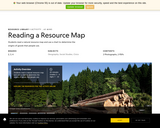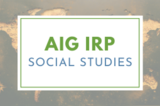
Students read a natural resource map and use a chart to determine the origins of goods that people use.
- Provider:
- National Geographic
- Author:
- Anne Haywood
- Date Added:
- 06/24/2019

Students read a natural resource map and use a chart to determine the origins of goods that people use.

After the teacher has led a discussion about how we depend on the physical environment and natural resources to meet basic needs, students will begin to help her make a list on the board of natural resources that we depend on and need for our survival. Students may list things such as: trees for lumber to build houses and furniture, water from springs and rivers, plants to eat and use for medicinal purposes, animals for food and food products, etc. Then higher-level students will research the Pilgrims and create a poster to show all the ways they had to depend on natural resources and the environment for survival. This lesson was developed by NCDPI as part of the Academically and/or Intellectually Gifted Instructional Resources Project. This lesson plan has been vetted at the state level for standards alignment, AIG focus, and content accuracy.

This inquiry is an initial exploration into the concepts of interdependence through the lens of community economics and the idea of an economy as a diverse, mutually supportive web of needs and wants, workers and consumers, and problems and solutions. This inquiry challenges students to understand that through businesses, town organizations, and local governments, a community meets the needs and wants of its people, finding strength in collective efforts to address problems.

This lesson will address the physical and human characteristics of the local community. Students will build geographic vocabulary as well as use map skills.

Students review the types of communities, examine physical and human characteristics of place, and compare the characteristics of communities.

In this lesson, students explore why people have settled near water and the roles that water serves for communities. Students will examine maps to identify large population centers near lakes, rivers, and coastlines. They will then use art supplies to create 3D models which demonstrate how and why a community may depend on a nearby water supply.